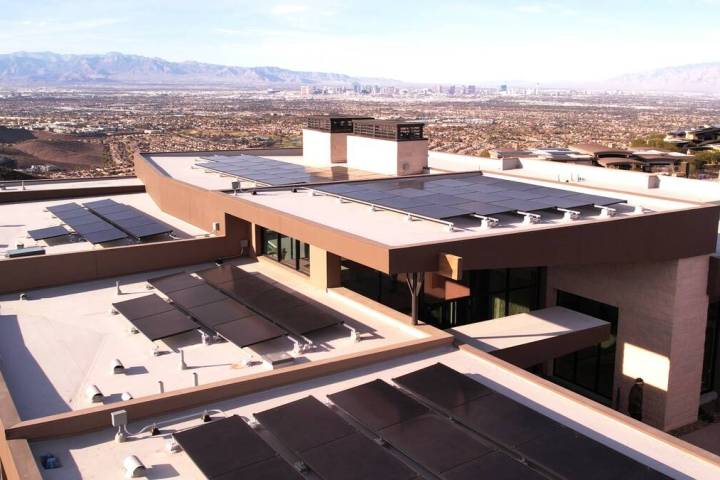
Summer is here and for Las Vegas building owners, this means that one of their most valuable assets is heating up in the desert: their building’s roof.
With Las Vegas averaging 310 sunny days per year, and the summer months of June through September averaging nearly 75 days of 100 degree or higher weather, this can have a drastic effect on the life of the roof and its performance to protect the contents within. Commercial building owners looking to protect their roof from the scorching summer heat and premature failure should consider inspecting their roofs now before it gets too hot.
UV rays are considered the number one cause of roofing degradation in our climate. Many commercial roofs come with a certain standard warranty — anywhere from 10 to 15 to 20 years. What most warranties don’t take into consideration, though, is the specific nature of the Las Vegas climate and just how hot it gets in the desert. With Las Vegas being an exceptionally hot, dry area, roofing materials break down at a higher rate than in locations like Southern California.
On a 60 degree day, a cap sheet roof can register temperatures around 114 degrees, so when outside temperatures reach into the triple digits, that kind of heat can take a devastating toll on a building’s roof. Being able to properly identify where your roof is degrading and catching it early can save commercial property owners from a number of expensive, long-term problems.
Inspecting your roof before the full swing of summer hits the area will ensure that it is capable of handling the harsh heat. Whether the inspection is done by a building maintenance staff member or a certified commercial roofing contractor, the inspector should examine both the interior and the exterior of the building every time.
When inspecting the interior, these are signs the roof needs maintenance:
■ Rust, or dark staining from rust, visible on joists or other structural components;
■ Cracked roof deck joists, purlins or glulam beams;
■ Water staining on roof decking or roof deck joists, or deterioration of the roof deck, especially at penetrations for mechanical equipment (HVAC or swamp cooler duct drops);
■ Raised or deteriorated areas on the walls below the roof deck;
■ Discolored or water-stained ceilings and walls;
■ Discoloration or water staining of window frames;
■ Mold on any interior surfaces.
On the building’s exterior, signs to look for include:
■ Cracks, blisters, punctures, ridging or “alligatoring” of the roof membrane;
■ Cracked masonry wall caps or parapets;
■ Defective, damaged or missing caulking at masonry tilt panel joints;
■ Loose, buckled or damaged flashing or roof membrane;
■ Nails or screws from deck backing out through membrane;
■ Gaps or cracks in caulking around roof penetrations (vents, antennas, skylights, HVAC units, etc.);
■ Vegetation in contact with the roof surface;
■ Debris on roof or in drains and gutters;
■ Missing domes on drains;
■ Bald or bare spots on the roof where UV reflective granules are missing from the cap sheet;
■ Excessive accumulation of granules on roof surface or in drain/gutter;
■ Cracks or discoloration of acrylic domes on skylights or smoke vents.
If your building’s roof hasn’t been inspected in a while, it’s also recommended to have a plumber check the roof drain lines. This is something that should be done once every few years.
In addition to looking for the right signs during a commercial roof inspection, creating standardized documentation for each building that is being inspected is a great way to help maintain proper records. The documentation should include:
■ A file for each roof;
■ The roof’s installation date;
■ Records of repairs or updates;
■ A map of any current leaks;
■ The administrator of the roofing program, along with contact information;
■ How often maintenance is performed.
Blank, printable inspection report forms can be found online (one source is http://www.highlandroof.com/commercial-roof-inspection-form.pdf), and using one form for each roof, plus taking photos during each roof inspection, will ensure building management has the most up-to-date, accurate records at all times.
Inspecting a commercial roof, especially before the heat of summer is in full swing, is one of the most important preventative maintenance tasks that owners should not overlook. Proper maintenance, especially by those who understand the heat of the Las Vegas climate, should be considered an investment, not an expense, as it can extend a roof’s life and reduces the potential for damage to the building’s interior and its contents.
Michael Jackson, a 30-year veteran of the roofing industry, is a senior project manager at Highland Commercial Roofing where he is in charge of all of Southern Nevada. He has been involved in millions of square feet of commercial roofing projects for shopping centers, manufacturing plants, commercial office buildings and industrial spaces.






